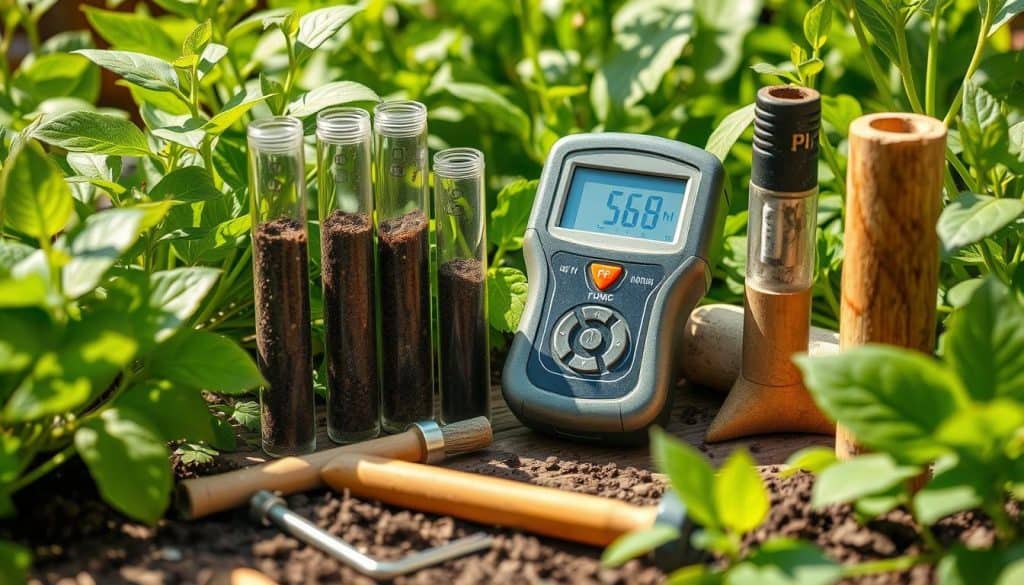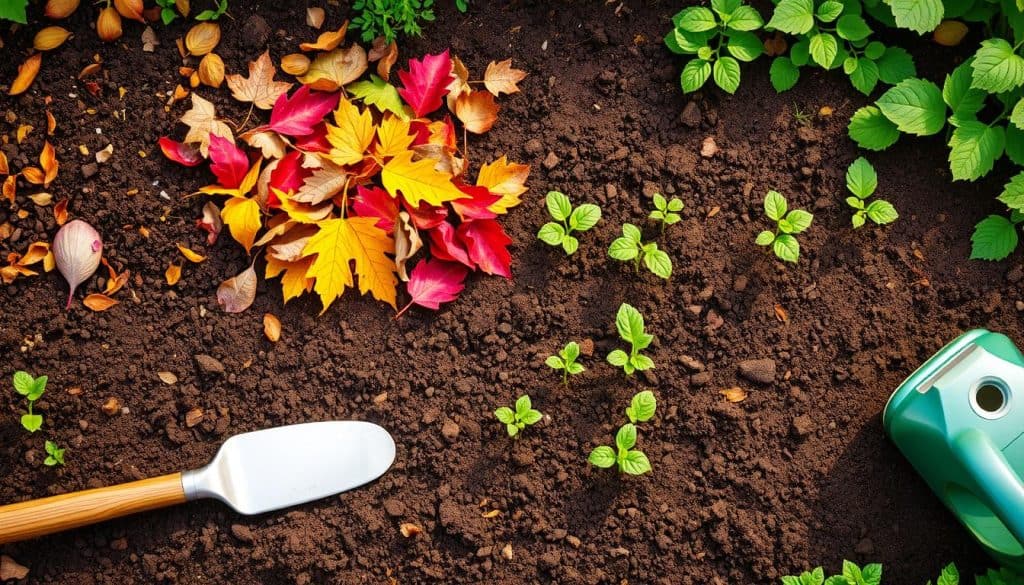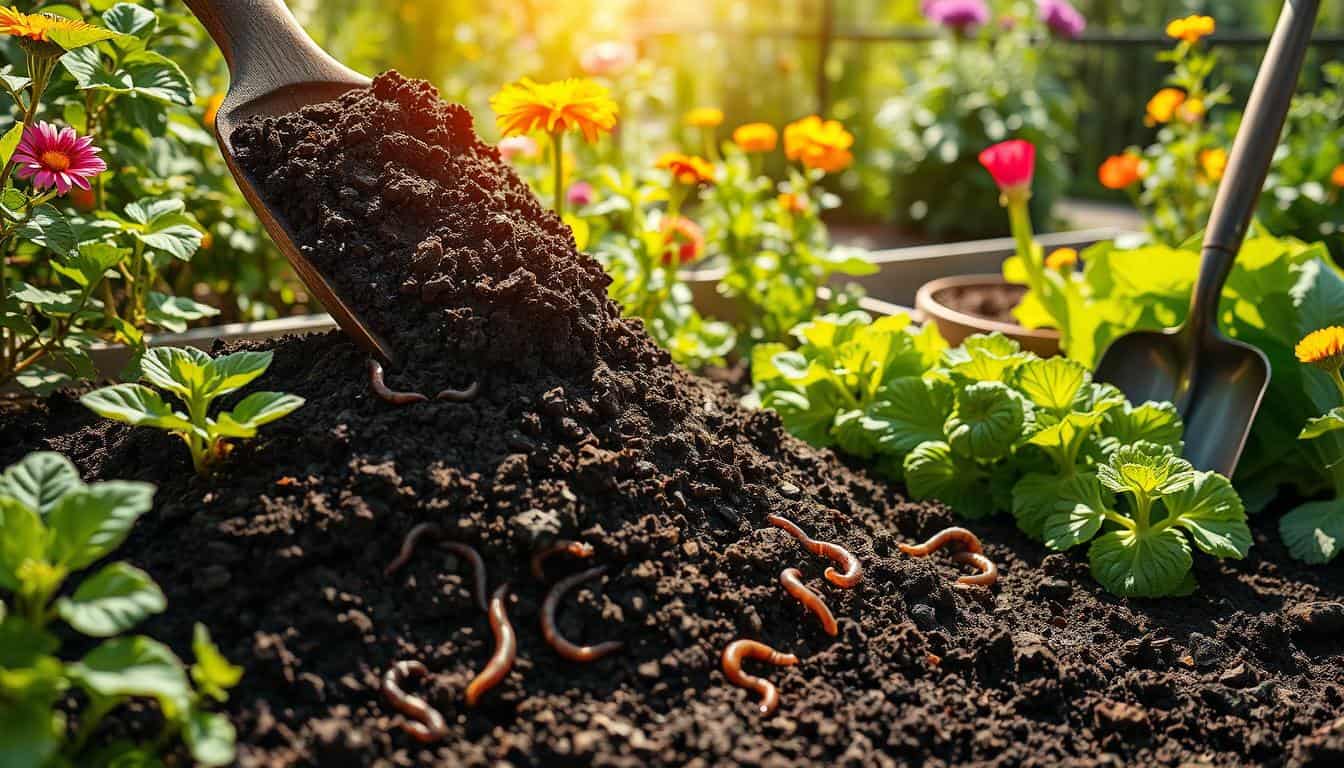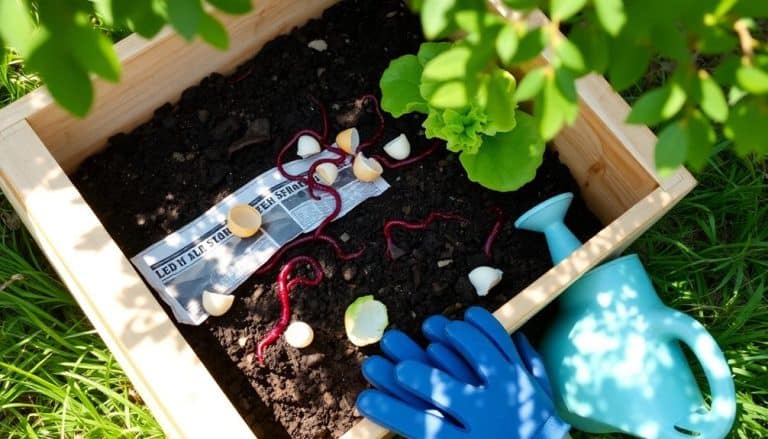This website contains affiliate links. Some products are gifted by the brand to test. As an Amazon Associate, I earn from qualifying purchases. The content on this website was created with the help of AI.
Your soil is a living ecosystem full of tiny creatures. Healthy soil contains billions of microorganisms in each teaspoon. These tiny beings create nutrient-rich soil for strong plant growth.
Compost is a game-changer for your garden’s soil health. It feeds helpful microorganisms and boosts soil fertility. Compost also keeps moisture in and fights plant diseases.
Food scraps and garden waste make up 28% of U.S. household trash. You can turn this waste into black gold for your garden. Composting at home makes a valuable resource for better soil.
Start by testing your soil to understand its needs. Then, add organic matter and compost to your garden beds. For flowers and veggies, mix 1-2 inches of compost 6-8 inches deep.
For trees and shrubs, go deeper. Add 4 inches of compost to a depth of 12 inches. This creates the best growing environment for your plants.
Key Takeaways
- Healthy soil contains billions of microorganisms per teaspoon
- Compost improves soil fertility and moisture retention
- Food scraps and garden waste can be composted instead of landfilled
- Soil testing is crucial for understanding nutrient needs
- Proper compost incorporation depths vary for different plants
- Organic matter in soil is key to a thriving garden ecosystem
Understanding the Living Ecosystem of Soil
Soil isn’t just dirt under your feet. It’s a bustling ecosystem vital for plant growth. Your garden’s success hinges on grasping this intricate world.
The Role of Microorganisms
Soil microorganisms are garden champions. These tiny beings break down organic matter, freeing nutrients for plants. A thriving soil food web creates resilient plants that naturally resist pests and diseases.
Soil Composition and Structure
Good soil balances minerals, organic matter, air, and water. Ideal structure allows roots to grow deep and strong. Well-structured soil retains moisture, making plants drought-resistant.
The Importance of Air and Water Balance
Proper air and water balance in soil is key for plant health. It supports root growth and nutrient uptake. Soil that drains well but holds moisture is best.
To check drainage, dig a 12-inch hole. If water drains within 8 hours, you’re good.
| Soil Component | Ideal Percentage | Function |
|---|---|---|
| Mineral particles | 45% | Provide structure and nutrients |
| Air | 25% | Allows root respiration |
| Water | 25% | Dissolves and transports nutrients |
| Organic matter | 5% | Feeds soil life, improves structure |
Healthy soil nurtures plants, traps carbon, and yields nutritious vegetables. By caring for your soil, you’re fostering an entire ecosystem.
Essential Nutrients for Healthy Soil
Soil nutrients are vital for growing healthy plants. Your garden needs the right mix of macro and micronutrients. It also requires proper soil pH for success.
Macronutrients: NPK and Their Functions
Nitrogen (N), phosphorus (P), and potassium (K) are key macronutrients. Nitrogen helps leaves grow. Phosphorus boosts root growth. Potassium improves overall plant health.
Secondary Nutrients and Micronutrients
Plants need smaller amounts of calcium, sulfur, and magnesium. Trace amounts of iron, zinc, and manganese are also important. These elements support various plant functions.
Understanding Soil pH Levels
Soil pH affects how plants get nutrients. Most plants like soil with a pH of 6.0-7.0. A soil test can help you check and adjust your soil’s pH.
| Soil pH Range | Classification | Nutrient Availability |
|---|---|---|
| Below 6.0 | Acidic | Low availability of phosphorus, calcium, magnesium |
| 6.0 – 7.0 | Neutral | Optimal for most nutrients |
| Above 7.0 | Alkaline | Low availability of iron, manganese, zinc |
Healthy soil can store 20 times its weight in water. Balancing nutrients and pH creates a thriving ecosystem beneath your feet. This helps your plants grow strong and healthy.
Improving Soil Health with Compost
Compost is a natural wonder that boosts soil health. It improves soil structure and enhances nutrient content. Compost also promotes a thriving ecosystem in your garden.
Types of Compostable Materials
Home composting requires the right ingredients. You can use a mix of kitchen scraps, yard waste, and paper products.
- Kitchen scraps (fruit and vegetable peels, coffee grounds)
- Yard waste (leaves, grass clippings)
- Paper products (shredded newspaper, cardboard)
Balance “green” nitrogen-rich materials with “brown” carbon-rich ones. This is key to successful composting techniques.
Creating Quality Compost at Home
Home composting is simple yet rewarding. Layer green and brown materials in a bin or pile. Keep the mix moist but not soggy.
Turn it regularly to add oxygen. In a few months, you’ll have rich, dark compost ready for use.
Application Methods and Timing
Compost application varies based on your garden’s needs. For flower beds and vegetable gardens, spread a 1-2 inch layer. Work it into the top 6-8 inches of soil.
When planting trees or shrubs, mix 4 inches of compost into the soil. Apply compost in spring or fall for best results.
Compost acts as a slow-release fertilizer. It feeds your plants gradually over time.
Using these composting techniques will improve your soil’s structure. It will also boost water retention and nutrient content. Your plants will grow robustly and produce bountiful harvests.
Signs of Healthy vs Unhealthy Soil
Healthy soil is dark, moist, and crumbly with visible air pockets. It contains diverse living organisms and supports robust plant growth. Unhealthy soil may be compacted, dry, or waterlogged, lacking organic matter and showing erosion signs.
Soil health indicators gauge changes in biological, chemical, and physical properties over time. Growers use these indicators to assess soil condition and make improvements. Key signs of healthy soil include good structure, beneficial microorganisms, and balanced pH levels.
Unhealthy soil may show compaction, poor aeration, and lack of organic material. It can also suffer from erosion, nutrient loss, and imbalanced pH levels. Plants in unhealthy soil often have stunted growth or nutrient deficiencies.
- Good soil structure with stable aggregates
- Presence of beneficial microorganisms and earthworms
- Balanced pH levels
- Adequate organic matter content
- Proper water retention and drainage
Unhealthy soil may exhibit these problems:
- Compaction and poor aeration
- Lack of organic material
- Erosion and nutrient loss
- Imbalanced pH levels
- Stunted plant growth or nutrient deficiencies
Regular soil testing and plant health observation provide insights into soil condition. Address issues promptly and use sustainable practices to improve soil health. This approach ensures your garden’s success and long-term productivity.
Organic Matter: The Foundation of Soil Health
Organic matter is crucial for healthy, productive soil. It makes up 1% to 5% of mineral soils by weight. Knowing its benefits and sources can boost your garden’s health and productivity.
Benefits of Organic Matter
Organic matter offers many advantages for your soil:
- Improves soil structure and reduces erosion
- Enhances water retention capacity
- Provides essential nutrients for plants
- Supports beneficial soil organisms
A 1% increase in organic matter helps soil hold 16,500 more gallons of water per acre. This extra water helps plants survive dry spells better.
Sources of Organic Matter
You can add organic matter to your soil from various sources:
- Compost
- Aged manures
- Leaf mold
- Cover crops
- Straw or hay mulch
Choose sources based on your garden’s needs and local availability. Straw or hay mulch costs $2 to $4 per bale. It’s an affordable option for many gardeners.
Integration Techniques
To get the most from organic matter, try these methods:
- Incorporate organic materials into the top 6-12 inches of soil
- Apply as mulch on the soil surface
- Grow cover crops and till them into the soil
It takes 100 tons of organic material to add 1% stable organic matter. Start small and be consistent. Over time, you’ll build healthy, organic-rich soil.
| Organic Matter Level | Nitrogen Release (lbs/acre/year) | Water Retention (gallons/acre) |
|---|---|---|
| 1% | 20-30 | 40,000 |
| 2% | 40-60 | 80,000 |
| 3% | 60-90 | 120,000 |
Soil Testing and Analysis Methods
Soil tests are key to understanding your garden’s health. They reveal nutrient levels, pH, and organic matter content. This info helps you avoid over-fertilizing and adjust pH as needed.
Home soil test kits offer quick checks of pH and basic nutrients. For deeper insights, try professional lab tests. These provide detailed analysis of soil makeup, including micronutrients.

To test soil, gather samples from various garden spots. Mix these to create a sample that represents your whole garden. This ensures accurate results for your overall soil health.
| Soil Type | Infiltration Rate (mm/hour) |
|---|---|
| Sand | >30 |
| Sandy loam | 20-30 |
| Loam | 10-20 |
| Clay loam | 5-10 |
| Clay | 1-5 |
Soil pH greatly affects plant health. A pH of 7 is neutral, below is acidic, above is alkaline. Most crops thrive in a pH range of 6-7.
Different plants have unique pH needs. For example, blueberries prefer a pH between 4.5 and 5. They need more iron, which is more available in acidic soil.
Soil testing should be done regularly. It helps track changes in soil health over time. By testing often, you can adjust your gardening practices for a thriving garden.
Managing Soil Compaction and Structure
Soil compaction harms garden health. It happens when soil particles are squeezed together. This limits air, water, and nutrient movement in the soil.
Compaction leads to poor drainage and reduced root growth. It can also decrease crop yields in your garden.
Prevention Techniques
To prevent soil compaction:
- Avoid working wet soil
- Use designated paths in your garden
- Minimize tillage
- Apply organic mulch regularly
- Practice no-till farming for larger areas
Remediation Strategies
If your soil is already compacted, try these remediation strategies:
- Add organic matter like compost
- Plant cover crops with deep roots
- Aerate the soil
- Implement proper drainage systems
Tools and Equipment
These tools can help manage soil structure:
| Tool | Use |
|---|---|
| Broadfork | Loosens soil without inverting layers |
| Garden fork | Aerates smaller areas |
| Mechanical aerator | Removes small plugs of soil |
| Raised beds | Improves drainage and prevents compaction |
Use these techniques to manage soil compaction. They’ll help create a thriving garden ecosystem. Your plants will grow healthier and stronger.
Seasonal Soil Care Practices
Good soil care is crucial for seasonal gardening success. Your soil needs different attention throughout the year. Let’s look at how to keep your garden thriving in each season.

Spring begins the gardening year. Test your soil to understand its needs. Mix compost into the top layer of soil. This improves nutrient content and soil structure.
For heavy clay, use more compost. Add up to 4 inches to boost organic matter. This helps create a healthier growing environment for your plants.
Summer heat requires mulching. Use organic mulches like bark or leaves. This keeps moisture in and regulates soil temperature. Mulching can reduce water use and extend flower blooming time.
Fall is ideal for soil improvement. Add organic matter and plant cover crops. These steps can boost next year’s harvest. Compost use can double productivity in raised beds.
Winter is the soil’s rest time. Plan next season’s soil care now. Consider crop rotation to prevent nutrient loss. Minimal tillage helps preserve soil structure and helpful microorganisms.
| Season | Soil Care Practice | Benefits |
|---|---|---|
| Spring | Soil testing, compost addition | Improved nutrient content, soil structure |
| Summer | Mulching | Moisture retention, temperature regulation |
| Fall | Organic matter addition, cover crops | Soil protection, nutrient boost |
| Winter | Planning, minimal tillage | Soil rest, structure preservation |
Regular soil care is key for long-term garden health. Add compost often and rotate crops. These practices create a thriving garden ecosystem year-round.
Sustainable Soil Management Techniques
Healthy soil is vital for productive gardens. Eco-friendly practices improve your garden while reducing environmental impact. No-till methods preserve soil structure and boost organic matter content.
Cover crops are essential for sustainable soil management. They prevent erosion and enhance soil fertility. Companion planting and crop rotation manage soil nutrients naturally.
Natural mulches like straw or leaves support a thriving garden ecosystem. Integrated pest management promotes healthier soil by reducing chemical use.
Rainwater collection for irrigation conserves resources and prevents soil erosion. These techniques improve soil health and help with carbon sequestration.
Studies show sustainable practices increase water retention by 20%. They also reduce synthetic fertilizer needs by 30%. These methods contribute to UN Sustainable Development Goals for soil health.




